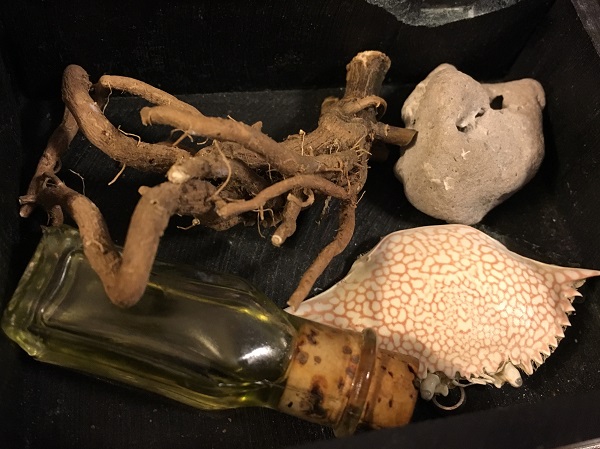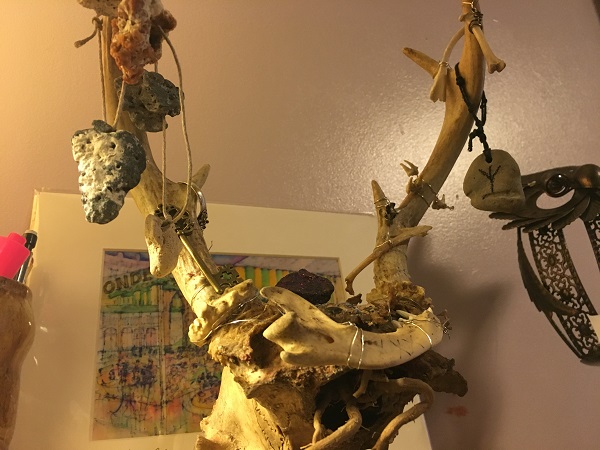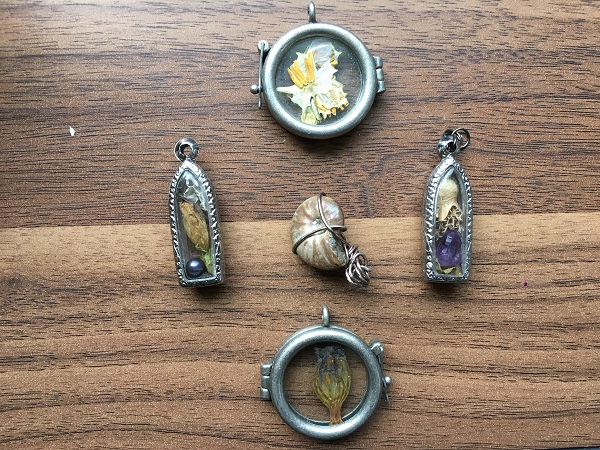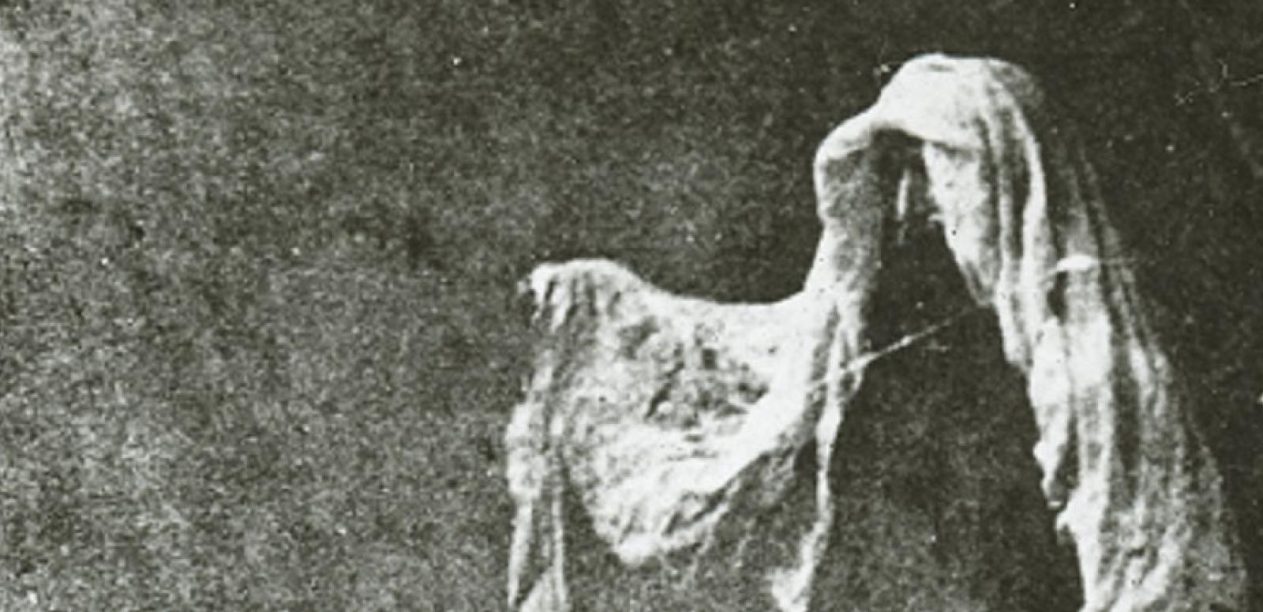By Coby Michael Ward via Patheos.com
A reliquary traditionally contains sacred material usually organic matter from a deceased person important to followers of the religion to which it belongs. Generally a reliquary will contain bones, blood on fabric, and other fragmental remains of various priests and mystics. Holy relics can be found in most of the world’s religious traditions. Relics are common in mystic religions especially those that are institutional in nature with a priestly caste that is responsible for preserving these relics. Christianity, Buddhism, and Islam are just a few examples of religions that have numerous holy relics. These objects were often beloved items of the person that they belonged to or were everyday items used on a regular basis. Whether an important object or actual bodily remains the relic has absorbed some of the person’s essence and acts as a conduit to the individual. A relic can take many forms; from statues of saints with miracles attributed to them to holy books once owned by venerated clerics. Often the source of miracles, the relic is a magical object that has also accrued additional power over time. Through repeated ritual adoration and offerings common ritual tools and objects can become powerful totems. Some relics are meant to be experienced by many while others are secreted away quietly kept by a few individuals.
Mundane everyday objects can become relics as well. For example, a comb used by a Buddhist monk becomes a relic upon his death and can be utilized as a means of testing individuals who are potentially the reincarnation of the deceased monk. Ancient Egyptians were masters at creating magical objects, using complex rituals to imbue them with power, these objects were often sent along with individuals on their journey into the afterlife. Scepters, jewelry, and weapons were some common artifacts that would be included in the tombs of Egyptian royalty. Objects play an important role in the religious traditions of humanity, satisfying an innate need to contain and control beneficial powers.
Arcane Relics

Arcane Artifacts. Belladonna root, Hagstone, Crab Shell. Photo courtesy of author.
In magical traditions virtually any object has the potential to become a container for magical power. Many occult practices are centered around particular tools that are utilized in ritual. The grimoire traditions for example contain many extensive rituals that pertain to the preparation of magical objects. Some objects by their nature innately contain occult powers already, and need only be activated and directed by the individual. Pagan traditions both past and present view nature as sacred, and as a manifestation of the spirit world. All natural objects especially those once containing life force are seen as potentially magical due to their existing connections. It is a common belief in modern Paganism that there are energies, and/or entities residing in the land itself and its flora and fauna. In Natural Magic the arcane forces of nature are connected with and utilized for one’s benefit. The objects that become the tools and charms of this particular practice are often found out in the local environment.
In Pagan traditions, Nature is the source of the sacred and often artifacts that can be used as relics are hewn by the unseen hands of the forces of Nature. Botanical, mineral and biological curios can be obtained and utilized in one’s practice for added power and nuance. Whether it be a large stone carved into a usable shape by running water or a lightning struck tree used to fashion numerous charms and amulets, these arcane artifacts contain a potent energy for those who know how to use it. Spirits also present us with these objects as needed, things like animal remains, rock crystal and other found objects make their way to us to benefit our practice. Connecting to the spirit within these objects often leads to additional knowledge of its potential purpose and uses.
Arcane Relics can also be created using occult means; just like the rituals used to consecrate and dedicate ceremonial tools. However, these objects are differentiated from regular working tools by a number of possible factors. Instead of a single preparatory ritual these objects would have layers of charms and enchantments placed over them for specialized purposes. The arcane relic would also occupy a prominent place on the main altar or oftentimes its own shrine dedicated solely to the display and propitiation of the relic. Some of these objects based on their spirits and general purpose, if not prominently displayed, are stored in a secretive and occult way. The third way a relic of Witch Power can come to be is an offshoot of the first two ways. Whether created by human hands or spirit hands, this tertiary magical object is what most of us would usually think of as a relic. When a tool is used by a prominent individual in the tradition, if not interred with them upon their death, the object is often venerated and passed down within the tradition accruing more potency with each passing. For example, the ritual tools of Gerald Gardner are typical relics of British Traditional Witchcraft and its Wiccan offshoots. The scrying glass of John Dee is another quintessential example of a historic arcane relic. It is important to note that to be considered a relic in this sense; it is not imperative that the object belonged to a prominent practitioner of the magical arts. Certain objects are set aside by the spirits that inhabit them, and it is by their nature that they are set apart from the usual tools of arte.
Container, Conductor and Vessel

Altar Relic. Created by the author utilizing root, bone and stone.
There are few objects within the Craft that are used for purely utilitarian purposes. Each object is at least enchanted in some way or contains some kind of occult symbol or virtue; nothing is without meaning. When trying to distinguish this category of magical apparatuses from those that already exist and have been giving full explanations in many introductory books on the topic, what stands out is the way the objects are used. A relic is not something that is manipulated or “used” in ritual like a magical tool would be “used.” To put it simply we are not waving our relics around tracing pentagrams or magic circles with them. These are venerated occult objects that have been set apart, elevated in a sense, like our working tools are set apart from mundane tools. A relic has its place on the altar and its main purpose is to act as a catalyst for a desired effect. The effect being either passive, active, or mutable it is always long term in nature like a kind of familiar relationship. The passive sense of the effect is to act as a battery to absorb and contain energy that can be used at a later time for a desired purpose. The active effect it can have is the projection of a specific effect be it protection or illusion, through regular offerings the relic continues to have its desired effect after an initial programming ritual. This same ritual could then be utilized to create the mutable effect of the relic which would mean its inhabitation by a spirit or elemental force that would act as partner, protector and guide. It becomes mutable because the familiar spirit has a mind of its own and will communicate and act accordingly.
Arcane Artifice
Another component that allows us to differentiate a Witch’s Relic from a regular tool or charm is its individualized nature and creation by spirit arte. Whether inhabited by spirits or created in company of spirits under their instruction these objects take on Otherworldly qualities. In this sense, a Witch’s Relic can be any number of things. It is akin to combining a specialized charm or amulet with a ritual tool or alar piece. Tools and charms also have their specific uses, activated by ritual ceremony, a relic has a spirit of its own and has its effect simply by its presence alone. The relic itself it often the focal point or catalyst for the magical operation.
Depending on the form it takes a relic can be worn, oftentimes they are set upon an altar since they are larger than inconspicuously worn amulets. However smaller vials, phylacteries and reliquary lockets can contain these objects made from various material magica. Reliquary pendants are beautiful and have become popular over the past few years, offering a more permanent option to the charm bag. There is a synthesis of multiple components in the reliquary consisting of symbolic parts connected and contained in some way to have a desired effect. Ornate lockets and other special containers filled with the remains of a plant spirit familiar, the witch’s hair and other precious curios are often the contents of these wearable artifacts. The container and its contents connected by the sorcerous arte form a new synthesis that is the sum of its individual components.

Reliquary Pendants, created and photographed by the author.
More commonly are the Witch’s Relics found on an altar or shrine. These can take the form of altar pieces bringing together diverse energies to act as touchstones for occult power. Items such as the plant spirit homunculi which contains all of the preserved parts of one’s plant spirit familiar, prepared in a way that is dictated by the spirits themselves. The relic acts as a type of spirit vessel for the familiar spirit and can be adapted to encompass any type of tutelary or protective spirit. The homunculi can be called upon in various types of workings, and when prepared as a liquid tincture vessel can be incorporated into other formulas as well. Other types of altar relics are fashioned into spirit houses uses other means of artifice and alchemy, working these rites to create the vessel of the Witch’s Relic is initiatory in itself. Each relic contains its own story and its own mysteries.
Any object used in magic would be considered an artifact, especially in an anthropological sense of the word. Artifice is the ritual creation of these magical objects. The arcane art of artifice itself is in the creation of new magical apparatuses that serve as houses for spirits and other beings of the Otherworld. Relics of Witch Power are different from charms that need to be recharged regularly, and ritual tools that need to be cleansed. Once enlivened and all of the components are brought together offerings are made and the relic acts as a cumulative container of magical power. The relic evolves as it grows in power and age, its spirit may request the addition of other components to the artifact. Arcane Relics are usually unique to each practitioner. These artifacts created by human hands guided by occult spirits serve as touchstones to the spirit world and reflect the spirit of the Witch’s practice.











